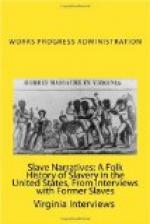“They had a farm right. We had peacocks, white guinea and big black turkeys, cows, sheep, goats, hogs; he had deer. He kept their horns cut off and some of the cow’s horns were off. We had a acre in a garden and had roses and all kinds of flowers. I like flowers now. Tries to have ’em. They had a gin on the place. He raised corn, rye, cotton, and tobacco. The hands got their supplies on Saturday. On rainy days all the women would knit, white and colored both. Miss Betty knitted some at night in winter. They had a shop to sharpen and keep all the tools in. A particular old man made the brooms and rakes.
“It seem like there wasn’t so many flies. Miss Betty mixed up molasses and flour and poison and killed flies sometimes. She spread it on brown paper. We had fly weed tea to set about too sometimes. We didn’t have to use anything regular. We didn’t have no screens. We had mighty few mosquitoes. We had peafowl fly brushes. They was mighty pretty.
“One thing we had was a deep walled well and an ice-house. They cut ice in blocks and put it up for winter[HW:?]. We had one spring on the place I know.
“They kept hounds. Colonel Radford’s boys and the colored boys all went hunting. We had ’possum and potatoes all along in winter; ’possum grease won’t make you sick. Eat all you want. I’d hear their horn and the dogs. They would come in hungry every time. I never seen no whiskey. He had his cider and vinegar press and made wine. We had cider and wine all along. Colonel Radford was his own overseer and Charlie his oldest boy. They whooped mighty little. They would stand up and be whooped. Some of the young ones was hard-headed and rude. He advised them and they minded him pretty well.
“Our yards was large and beautiful; some had grass and some clean spots about in the shade. Friday was wash day. Saturday was iron day. Miss Betty would go about in the quarters to see if the houses was scrubbed every week after washing. They had to wear clean clothes and have clean beds about her place. She’d shame them to death.
“Colonel Radford had a colored church for us all. It was a log house and he had a office for his boys to read and write and smoke cob pipes in. The white folks’ church was at the corner of his place. I went there most. They shouted and pat their hands. Colonel Radford was a Baptist.
“Nearly every farm had a fiddler. Ever so often he had a big dance in their parlor. I’d try to dance by myself. He had his own music by the hands on his place. He let them have dances at the quarters every now and then. Dancing was a piece of his religion.
“I don’t think our everyday frocks was stiffened but our dress up clothes was. It was made out of flour—boiled flour starch. We had striped dresses and stockings too. We had checked dresses. We had goobers and a chestnut grove. We had a huckleberry patch. We had maple sugar to eat. It was good. We had popcorn and chinquapins in the fall of the year, I used to pick up chips to use at the pot. I had a little basket. I picked up corn cobs. They burnt them and made corn cob soda to use in the bread and cakes. We parched peeled sweet potatoes slice thin and made coffee.




